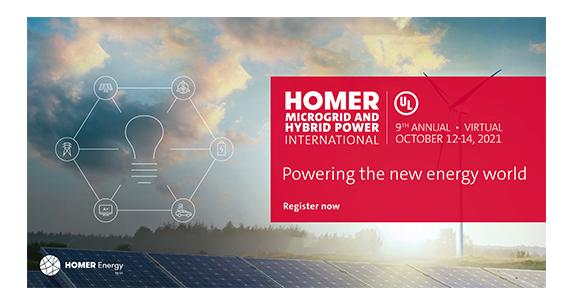India is one of the few countries on track to meet its obligations under the 1994 Paris Agreement under the United Nations Framework Convention on Climate Change, according to the Natural Resources Defense Council. The country has committed to cutting its greenhouse emissions to approximately 34% by 2030 from 2005 levels and to increase non-fossil fuel power capacity to 40%. India’s accomplishments will set an important example when the 26th Conference of the Parties begins on Nov. 1, 2021, in Glasgow, Scotland.
To meet these emissions goals, India must overcome a significant challenge. According to an electrical engineering professor at B.M.S. College of Engineering in Bangalore (Bengaluru), Venkatesh Boddapati, the country will need to increase electric vehicle (EV) use dramatically to succeed. Boddapati will present at HOMER Energy by UL’s 9th Annual HOMER Microgrid and Hybrid Power International conference, Oct. 12–14, 2021.
The electrification of India’s transportation sector will include the often used two- and three-wheeled vehicles, such as motorcycles, mopeds, scooters and rickshaws, plus private cars and commercial fleets. The electrification effort, Boddapati said, will require a rapid buildout of the country’s EV charging infrastructure, a project that faces significant hurdles.
The first hurdle: India’s electric utilities are financially challenged, according to the Carnegie Endowment for International Peace. Secondly, according to research by S & P Global, the country faces frequent capacity shortages, which drives commercial and industrial (C&I) customers to invest in their own, more reliable power sources. Third, India’s national or regional grid infrastructures will not be able to handle the sudden energy demands caused by EV charging in many locations. Since India produces about 70% of its electricity with nonrenewable, mostly coal-fired generation, EV charging stations tied to the current grid wouldn’t lower greenhouse gas emissions much.

One solution, said Boddapati, is creating hybrid power EV charging stations that can incorporate significant amounts of renewable energy in the nation’s energy mix. To that end, he has been working to develop a novel model for EV charging systems using hybrid energy sources.
In a recent project, Boddapati used UL’s HOMER® Pro to model and compare the economic and technical feasibility of grid-tied and off-grid — or autonomous — hybrid EV charging stations. He also analyzed each case for sensitivity to variations in fuel prices, inflation and discount interest rates. Boddapati found that both types of hybrid power EV charging stations succeeded in significantly reducing greenhouse gas emissions and other pollutants.
Boddapati modeled his EV charging stations with various energy resources, including solar, wind and backup diesel power. For the autonomous microgrids, he included energy storage in the resource mix. He also included biomass modeling to consider opportunities for charging stations located in the more rural areas of India, where biomass is a plentiful resource traditionally used for energy production.
He used HOMER software to determine the optimum sizing and design configuration of the different components and energy yields for the systems in each case. Boddapati has modeled projects in various locations, including at India’s National Institute of Technology at Tiruchirappalli (NITT), an EV charging station in Bangladesh, multiple projects in Africa, and the four major Indian cities of Bangalore, Mumbai, Chennai and Hyderabad. In each case, he used HOMER Pro to analyze values for the levelized cost of energy (LCOE), net present cost (NPC), initial cost and operating cost of the various configurations. Boddapati found that throughout India, grid-tied projects with solar PV and grid backup produced the lowest LCOE and NPC. In the locations modeled, adding wind did not further improve the economics.
In future research, Boddapati plans to explore refinements in EV charging station design using HOMER Grid.
About Venkatesh Boddapati
Venkatesh Boddapati was born in India and earned his bachelor of technology in electrical and electronics engineering from Acharya Nagarjuna University, Guntur, Andhra Pradesh, and his master of technology in power electronics from B.M.S. College of Engineering, Bangalore, Karnataka, India, in 2009 and 2011, respectively. He recently earned his doctoral degree in the Department of Electrical and Electronics Engineering (EEE) at NITT, Tiruchirappalli, Tamil Nadu, India, under the government’s AICTE-QIP scheme of India and B.M.S. College of Engineering, Bangalore. He currently serves as an assistant professor in the Department of EEE, B.M.S. College of Engineering, Bangalore. His areas of interest include renewable energy, microgrids and hybrid energy-based electric vehicle charging station design.
Register Now
Don’t miss the opportunity to attend HOMER Energy by UL’s 9th annual HOMER Microgrid and Hybrid Power International, which will be a virtual event this year. Venkatesh Boddapati will present the “Design and Feasibility Analysis of A Hybrid Energy-Based Electric Vehicle Charging Station” during the session dedicated to “C&I Behind-the-Meter Projects and EV Charging: Moving Toward a More Resilient, Mobile, Electrified Future” on Oct. 13, 2021, 3–5 p.m. MDT. This year’s conference theme, Powering the New Energy World, includes six separate online sessions over three days. Registration is complimentary.

